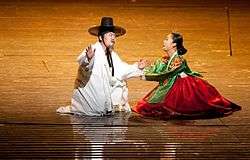Simcheongga
| Simcheongga | |
| Hangul | 심청가 |
|---|---|
| Hanja | 沈淸歌 |
| Revised Romanization | Simcheongga |
| McCune–Reischauer | Simch'ŏngga |
Simcheongga is one of the five surviving stories of the Korean pansori storytelling tradition. The other stories are Chunhyangga, Heungbuga, Jeokbyeokga, and Sugungga.
History

The exact date of when Simcheong story was adapted into a pansori is unknown. According to records, Simcheongga can be found in the Gwanuhui written by Manjae Song in the time of Sunjo of Joseon, and also in The History of Joseon Traditional Opera written by Nosik Hung in the 1900s.
Simcheongga is considered to have been made a great piece of art through the contribution of pansori singers' deoneum.
Simcheongga is the most tragic of the five pansoris. The story is almost wholly one of grief and sadness. Therefore, the melody sounds low and gloomy as well. In pansori, the feeling of the voice is more important than its purity or beauty: a beautiful voice can't express the joy and grief of living. To express deep sorrow, the pansori requires "a voice like geuneul (shadows)." In Simcheongga, the mystic geneul is important, so only a master singer of pansori is considered to possess the ability to perform Simcheongga well.
Story
There are five acts in the story. Simcheongga is about Simcheong and her father, Sim Hak-Gyu, whom people call Sim-Bongsa (Sim the Blind). She has to take care of her blind father. The sad story is occasionally lightened with humor.
The highlight of this pansori is when Sim-Bongsa regains his eyesight. A realistic expression of this requires a master singer of pansori. After Sim-Bongsa regains his eyesight, other blind people also recover. Finally, Simcheongga ends in a festive mood.[1]
Structure
① In Simcheong's birth section, Simcheong was originally a heavenly woman, and said that she had come to real world. This suggests that Simcheong was a non-realistic being. ② Growth and Prosperity of Simcheong, Simcheong grows up in the real world as a father's care. After she became mature, she worked for wages, begged to support her father and sold her body to 300 seoks of rice(It’s about 54,000 liters). At this situation, the place where Simcheong lived is the real world. ③ Death and surviving of Simcheong. In this paragraph, Simcheong became a sacrifice to the God of the sea and fell into Indangsu of the safety of the voyage, and went to the palace. It is unrealistic because where people can not go at choice. ④ Simcheong became a queen in the sea world. Her father opened his eyes and she met his father and lived happily. Like this, Simcheong who comes to the real world as a non-realistic being was born as a daughter of a blind man. And she went to the unrealistic place and came back to the real world again after enjoying happiness. So, the background space of Simchoengjeon changes form "unrealistic space → realistic space → unrealistic space → realistic space". Therefore, The flow of a novel shows a structure of circulation which the real world and the unreal world are exchanged with each other.
Now, let’s take a look at the contents of Simcheongjeon, focusing on the life of Sim-Bongsa.
① He lived with his wife and gave birth to his daughter Simcheong and lived happily in some wise. ② He lost her wife, lost her daughter and spent days of sorrow and pain. ③ He lived happily after seeing her queen daughter and opening Simcheong’s eyes. This work ends when the happiness of ① is changed into the suffering of ②, and this is overcome with happiness of ③ and happiness continues. So, fortune and misfortune don’t end in one circumstance, but show the structure of circulation in which the two situations change with each other. The 'Circulation of the realistic space and the unrealistic space' and 'The circulation of the happiness and unhappiness' appears in this novel is all based on the consciousness to make the new real world full of happiness, abolishing the unhappy reality. Koreans had the expectation and belief that today's hardships and misfortunes can be overcome tomorrow and live happily. So writer made a commitment to identify the hopes and expectations of tomorrow's happiness while enjoying making this novel.
See also
References
- ↑ 재미있는 우리국악 이야기,서해문집